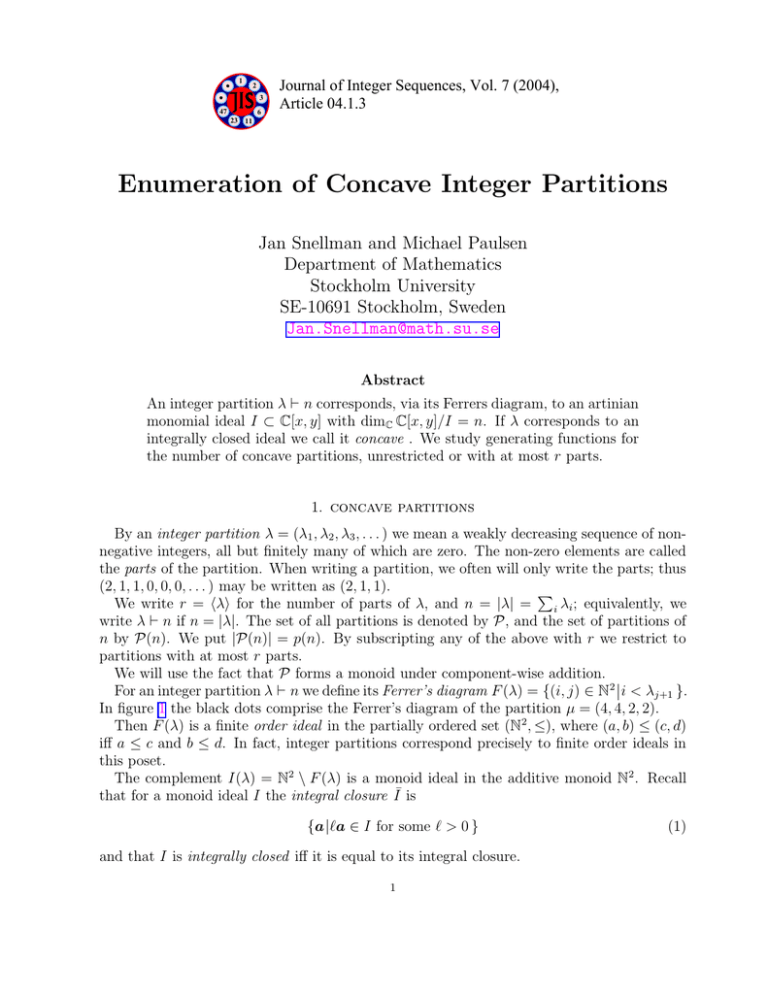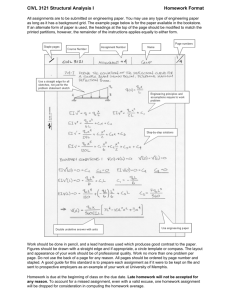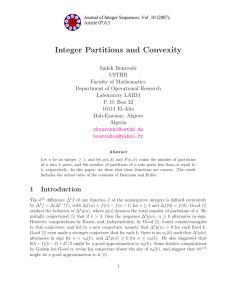Enumeration of Concave Integer Partitions
advertisement

1
2
3
47
6
Journal of Integer Sequences, Vol. 7 (2004),
Article 04.1.3
23 11
Enumeration of Concave Integer Partitions
Jan Snellman and Michael Paulsen
Department of Mathematics
Stockholm University
SE-10691 Stockholm, Sweden
Jan.Snellman@math.su.se
Abstract
An integer partition λ ` n corresponds, via its Ferrers diagram, to an artinian
monomial ideal I ⊂ C[x, y] with dimC C[x, y]/I = n. If λ corresponds to an
integrally closed ideal we call it concave . We study generating functions for
the number of concave partitions, unrestricted or with at most r parts.
1. concave partitions
By an integer partition λ = (λ1 , λ2 , λ3 , . . . ) we mean a weakly decreasing sequence of nonnegative integers, all but finitely many of which are zero. The non-zero elements are called
the parts of the partition. When writing a partition, we often will only write the parts; thus
(2, 1, 1, 0, 0, 0, . . . ) may be written as (2, 1, 1).
P
We write r = hλi for the number of parts of λ, and n = |λ| = i λi ; equivalently, we
write λ ` n if n = |λ|. The set of all partitions is denoted by P, and the set of partitions of
n by P(n). We put |P(n)| = p(n). By subscripting any of the above with r we restrict to
partitions with at most r parts.
We will use the fact that P forms a monoid under component-wise addition.
For an integer partition λ ` n we define its Ferrer’s diagram F (λ) = {(i, j) ∈ N 2 i < λj+1 }.
In figure 1 the black dots comprise the Ferrer’s diagram of the partition µ = (4, 4, 2, 2).
Then F (λ) is a finite order ideal in the partially ordered set (N2 , ≤), where (a, b) ≤ (c, d)
iff a ≤ c and b ≤ d. In fact, integer partitions correspond precisely to finite order ideals in
this poset.
The complement I(λ) = N2 \ F (λ) is a monoid ideal in the additive monoid N2 . Recall
that for a monoid ideal I the integral closure I¯ is
{a `a ∈ I for some ` > 0 }
and that I is integrally closed iff it is equal to its integral closure.
1
(1)
2
Definition 1. The integer partition λ is concave iff I(λ) is integrally closed. We denote by
λ̄ the unique partition such that I(λ̄) = I(λ).
Now let R be the complex monoid ring of N2 . We identify N2 with the set of commutative
monomials in the variables x, y, so that R ' C[x, y]. Then a monoid ideal I ⊂ N2 corresponds
to the monomial ideal J in R generated by the monomials {xi y j (i, j) ∈ I }. Furthermore,
since the monoid ideals of the form I(λ) are precisely those with finite complement to N 2 ,
those monoid ideals will correspond to monomial ideals J ⊂ R such that R/J has a finite Cvector space basis (consisting of images of those monomials not in J). By abuse of notation,
such monomial ideals are called artinian, and the C-vector space dimension of R/J is called
the colength of J.
We get in this way a bijection between
(1) integer partitions of n,
(2) order ideals in (N2 , ≤) of cardinality n,
(3) monoid ideals in N2 whose complement has cardinality n, and
(4) monomial ideals in R of colength n.
Recall that if a is an ideal in the commutative unitary ring S, then the integral closure ā
consists of all u ∈ S that fulfill some equation of the form
sn + b1 sn−1 + · · · + bn = 0,
b i ∈ ai
(2)
Then a is always contained in its integral closure, which is an ideal. The ideal a is said to
be integrally closed if it coincides with its integral closure.
Note that this notion is different from the integral closure of a as a subring of S. On
the other hand, one can show1 that the integral closure of the Rees algebra S[at] ⊆ S[t] is
equal to the graded subring
S + āt + · · · + an tn + · · ·
For the special case S = R, we have that the integral closure of a monomial ideal is again
a monomial ideal, and that the latter monomial ideal corresponds to the integral closure
of the monoid ideal corresponding to the former monomial ideal [9, 14]. Hence, we have a
bijection between
(1) concave integer partitions of n,
(2) integrally closed monoid ideals in N2 whose complements have cardinality n, and
(3) integrally closed monomial ideals in R of colength n.
Fröberg and Barucci [3] studied the growth of the number of ideals of colength n in certain
rings, among them local noetherian rings of dimension 1. Studying the growth of the number
of monomial ideals of colength n in R is, by the above, the same as studying the partition
function p(n). In this article, we will instead study the growth of the number of integrally
closed monomial ideals in R, that is, the number of concave partitions of n.
2. Inequalities defining concave partitions
It is in general a hard problem to compute the integral closure of an ideal in a commutative
ring. However, for monomial ideals in a polynomial ring, the following theorem, which can
be found in [7, Exercise 4.23] or in [9, 14], makes the problem feasible.
1See
for instance [13, chapter 6.6]
3
×
×
×
×
×
×
×
×
×
×
×
×
•
•
×
×
×
×
•
×
×
×
×
×
•
•
×
×
×
×
•
•
×
×
×
×
•
•
•
•
×
×
•
•
•
×
×
×
•
•
•
•
×
×
•
•
•
•
×
×
Figure 1. µ and µ̄
Theorem 2.1. Let I ⊂ N2 be a monoid ideal, and regard N2 as a subset of Q2 in the natural
way. Let convQ (I) denote the convex hull of I inside Q2 . Then the integral closure of I is
given by
convQ (I) ∩ N2
(3)
Example 2. The partition µ = (4, 4, 2, 2) corresponds to the monoid ideal
((0, 4), (2, 2), (4, 0)),
which has integral closure
((0, 4), (1, 3), (2, 2), (3, 1), (4, 0)).
It follows that µ = (4, 3, 2, 1). In figure 1 we have drawn the lattice points belonging to F (µ)
as dots, and the lattice points belonging to I(λ) as crosses.
The above theorem gives the following characterization of concave partitions:
Lemma 2.1. Let λ = (λ1 , λ2 , λ3 , . . . ) be a partition. Then λ is concave iff for all positive
integers i < j < k,
k−j
j−i
+ λk
(4)
λj < 1 + λ i
k−i
k−i
or, equivalently, if
λi (j − k) + λj (k − i) + λk (i − j) < k − i
(5)
Since all quantities involved are integers, (5) is equivalent to
λi (k − j) + λj (i − k) + λk (j − i) ≥ i − k + 1
(6)
3. Generating functions for super-concave partitions
We will enumerate concave partitions by considering another class of partitions which is
more amenable to enumeration, yet is close to that of concave partitions.
Definition 3. Let λ = (λ1 , λ2 , λ3 , . . . ) be a partition. Then λ is super-concave iff for all
positive integers i < j < k,
λi (k − j) + λj (i − k) + λk (j − i) ≥ 0
(7)
The reader should note that it is actually a stronger property to be super-concave than
to be concave. Unlike the latter property, it is not necessarily preserved by conjugation:
the partition (2) is super-concave, hence concave, but its conjugate (1, 1) is concave but not
super-concave.
4
Theorem 3.1. Let λ = (λ1 , λ2 , λ3 , . . . ) be a partition, and let µ = (µ1 , µ2 , µ3 , . . . ) be its
conjugate, so that |{j µj = i }| = λi − λi+1 for all i. Then the following are equivalent:
(i) λ is super-concave,
(ii) for all positive `,
−λ` + 2λ`+1 − λ`+2 ≤ 0
(8)
(iii) for all positive `,
λ`+1 − λ` ≥ λ`+2 − λ`+1
(9)
(iv) |{k µk = i }| ≥ |{k µk = j }| whenever i ≤ j.
Proof. (i) ⇐⇒ (ii): Let ei be the vector with 1 in the i’th coordinate and zeros elsewhere,
let f j = −ej + 2ej+1 − ej+2 , and let ti,j,k = (j − k)ei + (k − i)ej + (j − i)ek . Clearly,
(7) is equivalent with ti,j,k · λ ≤ 0, and (8) is equivalent with f j · λ ≤ 0. We have that
f ` = t`,`+1,`+2 . Conversely, we claim that ti,j,k is a positive linear combination of different
f ` . From this claim, it follows that if λ fulfills (8) for all ` then λ is super-concave.
We can without loss of generality assume that i = 1. Then it is easy to verify that
t1,j,k =
j−2
X
`=1
`(k − j)f ` +
k−2
X
`=j−1
(ii) ⇐⇒ (iii) ⇐⇒ (iv) : This is obvious.
`(j − 1)(k − ` − 1)f `
(10)
¤
The difference operator ∆ is defined on partitions by
∆(λ1 , λ2 , λ3 , . . . ) = (λ1 − λ2 , λ2 − λ3 , λ3 − λ4 , . . . )
(11)
We get that the second order difference operator ∆2 is given by
∆2 (λ1 , λ2 , λ3 , . . . ) = ∆(∆(λ1 , λ2 , λ3 , . . . )) =
= (λ1 − 2λ2 + λ3 , λ2 − 2λ3 + λ4 , λ3 − 2λ4 + λ5 , . . . ) (12)
Corollary 3.1. The super-concave partitions are precisely those with non-negative second
differences.
Definition 4. Let psc (n) denote the number of super-concave partitions of n, and psc (n, r)
denote the number of super-concave partitions of n with at most r parts. Let similarly
pc (n) and pc (n, r) denote the number of concave partitions of n, and the number of concave
partitions of n with at most r parts, respectively. For a partition λ = (λ 1 , λ2 , . . . ) let
xλ = xλ1 1 xλ2 2 · · ·, and define
X
P S(x) =
xλ
λ super-concave
P Sr (x1 , . . . , xr ) = P S(x1 , x2 , . . . , xr , 0, 0, 0, . . . ) =
X
xλ
λ super-concave
λr+1 =0
P C(x) =
X
xλ
λ concave
P Cr (x1 , . . . , xr ) = P C(x1 , x2 , . . . , xr , 0, 0, 0, . . . ) =
X
λ concave
λr+1 =0
xλ
(13)
5
Partitions with non-negative second differences have been studied by Andrews [2], who
proved that there are as many such partitions of n as there are partitions of n into triangular
numbers.
Canfield et al [5] have studied partitions with non-negative m’th differences. Specializing
their results to the case m = 2, we conclude:
Theorem 3.2. Let n, r be denote positive integers.
(i) There is a bijection between partitions of n into triangular numbers and super-concave
partitions.
(ii) The multi-generating function for super-concave partitions is given by
P S(x) = Q ³
∞
i=1
1−
1
Qi
1+i−j
j=1 xj
´
(14)
= 1 + x 1 + x 1 2 + x 1 3 + x 1 4 + x 1 2 x2 + x 1 5 + x 1 4 x2 + x 1 3 x2 + . . .
(iii) The multi-generating function for super-concave partitions with at most r parts is given
by
1
´
P Sr (x1 , x2 , . . . , xr ) = Q ³
(15)
Q
r
i
1+i−j
1
−
x
i=1
j=1 j
(iv) The generating function for super-concave partitions is
P S(t) =
∞
X
n
psc (n)t =
n=0
∞
Y
i=1
1
1−t
i(i+1)
2
(16)
and the one for super-concave partitions with at most r parts is
P Sr (t) =
∞
X
n
psc (n, r)t =
n=0
r
Y
i=1
1
1−t
i(i+1)
2
(17)
(v) The proportion of super-concave partitions with at most r parts among all partitions
with at most r parts is
r!
Qr
i(i+1)
i=1
2
(vi) As n → ∞,
.
(18)
psc (n) ∼ cn−3/2 exp(3Cn1/3 )
√ µ ¶3/2
(19)
3 C
2/3
−1/3
C=2
[ζ(3/2)Γ(3/2)] , c =
12
π
¡
¢∞
The sequence psc (n) n=0 is identical to sequence A007294 in OEIS [10]. We have submit¡
¢∞
ted the sequences psc (n, r) n=0 , for r = 3, 4, in OEIS [10], as A086159 and A086160. The
sequence for r = 2 was already in the database, as A008620.
6
3.1. Other appearances of super-concave partitions in the literature. The bijection
between partitions into triangular numbers and partitions with non-negative second difference is mentioned in A007294 in OEIS [10], together with a reference to Andrews [2]. That
sequence has been contributed by Mira Bernstein and Roland Bacher; we thank Philippe
Flajolet for drawing our attention to it.
Gert Almkvist [1] gives an asymptotic analysis of psc (n) which is finer than (19).
Another derivation of the generating functions above can found in a forthcoming paper
“Partition Bijections, a Survey” [8] by Igor Pak. He observes that the set of super-concave
partitions with at most r parts consists of the lattice points of the unimodular cone spanned
by the vectors v0 = (1, . . . , 1) and vi = (i − 1, i − 2, . . . , 1, 0, 0, . . . ) for 1 ≤ i ≤ r.
Corteel and Savage [6] calculate rational generating functions for classes of partitions
defined by linear homogeneous inequalities. This applies to super-concave partitions, but not
directly to concave partitions, since the inequalities (5) defining them are inhomogeneous.
4. Generating functions for concave partitions
Recall that a concave partition λ = (λ1 , λ2 , . . . ) fulfills (6), and that conversely, every
sequence of non-negative integers which is eventually zero and fulfills (6) gives a concave
partition. If we fix a positive integer r, then we need only finitely many of the inequalities
in (6): we can take those indexed by i < j < k < r + 2, together with the non-negativity
conditions λi ≥ 0. Hence, there is a matrix A with r columns, and whose rows are indexed
by tuples (i, j, k) with k ≤ r +1, so that a concave partition with at most r parts corresponds
to a solution to
Aλ ≥ b,
λ ∈ Nr ,
(20)
whereas a super-concave partition with at most r parts corresponds to a solution to
Aλ ≥ 0,
λ ∈ Nr .
(21)
We let K = {α ∈ Rr Aα ≥ b, α ≥ 0 }, P = {α ∈ Rr Aα ≥ 0, α ≥ 0 }. Then P is a rational polyhedron in the positive orthant. Since the RHS vector b is non-positive, P contains its
recession cone K. The solutions to (21) and (20) are precisely KI = K∩Nr and PI = P ∩Nr ,
and the generating functions of these two sets of lattice points are precisely P S r and P Cr .
Example 5. If r = 3 and if we order the 3-subsets of {1, 2, 3, 4} as 123, 124, 134, 234 then
1 −2 1
2 −3 0
b = (−1, −2, −2, −1)t .
A=
1 0 −3 ,
0 1 −2
K is the cone generated by the rays (1, 0, 0), (2, 1, 0), and (3, 2, 1), whereas P is the Minkowski
sum of K and the polytope which is the convex hull of (0, 0, 0), (0, 0, 1/2, (0, 1/3, 2/3),
(0, 1/2, 0), (0, 2/3, 1/3), (0, 2/3, 2/3). So P is a rational polyhedron but not a lattice polyhedron.
Lemma 4.1. The generating function P Cr (x1 , . . . , xr ) is a rational function with the same
denominator as P Sr (x1 , . . . , xr ), and with a numerator which evaluates to 1 at (1, . . . , 1). In
7
other words,
Qr (x1 , . . . , xr )
´,
³
Qi
1+i−j
1
−
x
i=1
j=1 j
P Cr (x1 , . . . , xr ) = Q
r
Qr (1, . . . , 1) = 1.
(22)
Proof. This can be obtained from the corresponding result for linear diophantine equalities 2
by adding slack-variables and then specializing the corresponding formal variables to 1. We
give the outline of a self-contained proof.
By Gordan’s lemma3, KI is a finitely generated affine semigroup. In fact, it has a unique
finite minimal generating set, called its Hilbert basis. Furthermore, PI is a module over KI,
by which we mean that KI + PI ⊆ PI. Now let R = C[KI] be the semigroup ring on KI,
i.e. the C-vector space spanned by all monomials {xα α ∈ KI }. We define
xαxβ = xα+β,
(23)
and extend this multiplication by linearity to all of R, turning it into a r-multigraded, noetherian C-algebra. Similarly, we define M to be the C-linear span of monomials corresponding to points in PI. (20). The multiplication (23) gives M the structure of r-multigraded
R-module.
Since KI is a finitely generated affine semigroup, R is a finitely generated C-algebra. Since
it is a subring of C[x1 , . . . , xr ], it is an integral domain. The Hilbert series of R is P Sr , and
the Hilbert series of M is P Cr .
Now note that since there is some γ ∈ Nr such that PI + γ ⊆ KI, it follows that M is
isomorphic as an R-module to the ideal xγ M ⊆ R. Consequently, M is a finitely generated
torsion-free module over R, of rank 1. Its annihilator is zero, so M has the same dimension
as R.
It follows from standard commutative algebra4 that the Hilbert series of R and M are
rational, of the form
NR (x1 , . . . , xr )
Qs
αi
i=1 (1 − x )
and
NM (x1 , . . . , xr )
Qs
,
αi
i=1 (1 − x )
where the αi ’s are the elements of a basis of KI, and the polynomials NR and NM have
rational coefficients. Since we know the Hilbert series of R, we conclude that the vectors
(i, i − 1, . . . , 0, . . . , 0), for 1 ≤ i ≤ r, form a basis for KI.
Furthermore5, NR (1, . . . , 1) = 1 , and NM (1, . . . , 1) = rank(M ) = 1. The ring R is CohenMacaulay, hence6 all coefficients of NR (t, . . . , t) are non-negative. As calculated in (28),
the polynomials NM (t, . . . , t) have some negative coefficients for r = 2, 3, 4, so M is not
Cohen-Macaulay in general.
¤
We can say something more about the numerators:
Theorem 4.1. Let r be a fixed positive integer. Then
2See
[11, Corollary 3.8] and the paragraph immediately following it
lemma says the lattice points in a finitely generated rational cone in the positive orthant
constitute a normal affine semigroup, see [4, Proposition 6.1.2]
4See [11, Theorem 2.3], and note that M is Nr -graded rather than Zr -graded
5See [4] , exercise 4.4.12
6See again [4] , exercise 4.4.12
3Gordan’s
8
(A) The multigenerating function of concave partitions with at most r parts is given by (22),
where Qr (x1 , . . . , xr ) is a polynomial with integer coefficients such that all exponent
vectors of the monomials that occur in Qr are weakly decreasing.
(B) The generating function for concave partitions with at most r parts is given by
∞
X
Qr (t)
´
(24)
P Cr (t) =
pc (n, r)tn = Q ³
i(i+1)
r
2
1
−
t
n=0
i=1
where Qr (1) = 1, and the numerator has degree strictly smaller than r 3 /6 + r2 /2 + r/3.
(C) pc (n, r) ∼ psc (n, r) as n → ∞.
(D) The proportion of concave partitions with at most r parts among all partitions with at
most r parts is the same as the proportion of super-concave partitions with at most r
parts among all partitions with at most r parts, namely
r!
(25)
Qr i(i+1) .
i=1
2
(E) Qr (x1 , . . . , xr ) = Qr+1 (x1 , . . . , xr , 0).
(F)
Q(x)
´
P C(x) = Q ³
Qi
∞
1+i−j
j=1 xj
i=1 1 −
(26)
where Q(x) is a formal power series with the property that for each `, Q(x 1 , . . . , x` , 0, 0, . . . ) =
Q` (x1 , . . . , x` ); in other words,
∞
X
Q=1+
(Qi − Qi−1 )
i=1
Proof. All monomials in
r
Y
i=1
Ã
1−
i
Y
j=1
x1+i−j
j
!
have weakly decreasing exponent vectors, as have all monomials in the power series P Cr (x1 , . . . , xr ).
Summing weakly decreasing exponent vectors gives weakly decreasing exponent vectors, so
all exponent vectors in Qr (x1 , . . . , xr ) are weakly decreasing.
If we specialize x1 = x2 = · · · = xr = t we get
1
Qr (t)
´,
´.
P Sr (t) = Q ³
P Cr (t) = Q ³
i(i+1)
i(i+1)
r
r
2
2
i=1 1 − t
i=1 1 − t
Thus Qr (1) = 1, and we conclude that pc (n, r) ∼ psc (n, r) as n → ∞.
Furthermore, from Stanley’s “grey book” [12, Theorem 4.6.25] we have that the rational
function P Cr (t, . . . , t) is of degree < 0. The degree of the denominator is
r
X
r3 r2 r
i(i + 1)
=
+
+
2
6
2
3
i=1
so Qr (t) have smaller degree than that.
If (λ1 , . . . , λr , λr+1 ) is a concave partition, then so is (λ1 , . . . , λr , 0); it follows that Qr+1 (x1 , . . . , xr , 0) =
Qr (x1 , . . . , xr ). The assertion about P C(x) follows by passing to the limit.
¤
9
By generating all concave partitions of n with at most r parts, up to a large n, we have
calculated that
Q1 (x) = 1
and that
Q2 (x) = 1 + x1 x2 − x21 x2
¡
¢
Q3 (x) = Q2 (x) + x3 x1 5 x2 3 − x1 4 x2 3 − 2 x1 3 x2 2 + x1 2 x2 2 + x1 x2
(27)
Q1 (t) = 1
Q2 (t) = 1 + t2 − t3
Q3 (t) = 1 + t2 + t5 − 2t6 − t8 + t9
2
4
5
6
7
(28)
9
10
11
12
Q4 (t) = 1 + t + t + t − t − t + 2t − 2t − t − 2t +
+ 2t13 − t14 − t15 + t16 + t17 + t18 − t19
We have also used the package LinDiophanthus [15] by Doron Zeilberger to verify our results.
By generating all concave partitions of n for n ≤ 20 we have calculated that
P C(t) =
∞
X
pc (n)tn = 1 + t + 2t2 + 3t3 + 4t4 + 7t5 + 9t6 + 11t7 +
n=0
+ 17t8 + 23t9 + 28t10 + 39t11 + 48t12 + 59t13 + 79t14 +
+ 100t15 + 121t16 + 152t17 + 185t18 + 225t19 + 280t20 + O(t21 ) (29)
Based on (28), we conjecture that
1 + t2 + O(t3 )
´
P C(t) = Q ³
i(i+1)
∞
2
i=1 1 − t
(30)
We also conjecture that log pc (n) grows as n1/3 , i.e. approximately as fast as super-concave
partitions.
¡
¢∞
¡
¢∞
The sequences pc (n) n=0 are in the OEIS [10] as A084913. The sequences pc (n, r) n=0
are A086161, A086162, and A086163 for r = 2, 3, 4.
References
[1] Gert Almkvist. Asymptotics of various partitions. manuscript.
[2] George E. Andrews. MacMahon’s partition analysis. II. Fundamental theorems. Ann. Comb., 4(3-4):327–
338, 2000. Conference on Combinatorics and Physics (Los Alamos, NM, 1998).
[3] Valentina Barucci and Ralf Fröberg. On the number of ideals of finite colength. In Geometric and
combinatorial aspects of commutative algebra (Messina, 1999), volume 217 of Lecture Notes in Pure
and Appl. Math., pages 11–19. Dekker, New York, 2001.
[4] Winfried Bruns and Jürgen Herzog. Cohen-Macaulay rings. Cambridge University Press, Cambridge,
1993.
[5] Rod Canfield, Sylvie Corteel, and Pawel Hitczenko. Random partitions with non-negative r-th differences. Adv. in Appl. Math., 27(2-3):298–317, 2001. Special issue in honor of Dominique Foata’s 65th
birthday (Philadelphia, PA, 2000).
[6] S. Corteel and C. D. Savage. Partitions and compositions defined by inequalities. math.CO/0309110.
[7] David Eisenbud. Commutative Algebra with a View Toward Algebraic Geometry, volume 150 of Graduate
Texts in Mathematics. Springer Verlag, 1995.
[8] Igor Pak. Partition bijections, a survey. Ramanujan Journal, to appear.
10
[9] Veronica Crispin Quinonez. Integrally closed monomial ideals and powers of ideals. Technical report,
Stockholm University, 2002.
[10] Neil J. A. Sloane. The on-line encyclopedia of integer sequences. http://www.research.att.com/
~njas/sequences/index.html.
[11] Richard P. Stanley. Combinatorics and Commutative Algebra, volume 41 of Progress in Mathematics.
Birkhäuser, 2 edition, 1996.
[12] Richard P. Stanley. Enumerative combinatorics. Vol. 1. Cambridge University Press, Cambridge, 1997.
With a foreword by Gian-Carlo Rota, Corrected reprint of the 1986 original.
[13] Wolmer V. Vasconcelos. Computational Methods in Commutative Algebra and Algebraic Geometry.
Algorithms and Computations in Mathematics. Springer Verlag, 1998.
[14] R. Villarreal. Monomial Algebras. Marcel Dekker, 2001.
[15] Doron Zeilberger. Lindiophantus. http://www.math.temple.edu/~zeilberg/, 2001. Program for calculating multi-generating functions for solution sets of systems of diophantine equations.
2000 Mathematics Subject Classification: Primary 05A17; Secondary 13B22.
Keywords: integer partitions, monomial ideals, integral closure.
(Concerned with sequences A007294, A086159, A086160, A008620, A084913, A086161, A086162,
A086163.)
Received October 6 2003; revised version received February 11 2004. Published in Journal
of Integer Sequences, February 11 2004.
Return to Journal of Integer Sequences home page.








